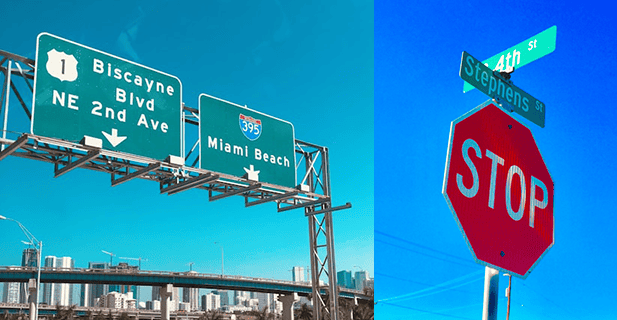

Road guide signs are an essential component of the transportation infrastructure, providing crucial information to drivers to ensure safe and efficient travel. These signs play a vital role in guiding motorists to their destinations, offering clear and concise directions, and highlighting key points of interest along the way.
From identifying highway exits to rest areas, indicating distances to various cities, or tourist attractions, etc., road guide signs serve as navigational aids that contribute to the overall convenience and accessibility of road networks. Whether in urban or rural settings, these signs are designed to benefit drivers by alerting them to facilitate informed decision-making, ultimately promoting smoother traffic flow and reducing the likelihood of navigation-related incidents.

Regulation of road guide signs in the United States is primarily the responsibility of the Federal Highway Administration (FHWA), which has established a comprehensive set of standards known as the Manual on Uniform Traffic Control Devices (MUTCD). The MUTCD is currently an online document that outlines the national standards for all traffic control devices, including road signs, signals, and pavement markings.
By law, states must adopt the MUTCD or a state-specific version that is in substantial conformance with the national manual. Some states, such as Florida, have their own specific criteria and programs for guide signs, but these must still comply with the MUTCD. Local governments are required to follow these federal standards, ensuring uniformity and predictability for road users across the country.
The FHWA updates the MUTCD periodically, with the latest edition reflecting changes to improve safety for all road users. State departments of transportation, like the Florida Department of Transportation (FDOT) and the South Carolina Department of Transportation (SCDOT), are responsible for implementing these standards on the roads they maintain. The MUTCD’s role as the authoritative guide for traffic control devices ensures that road guide signs across the U.S. provide consistent and clear information to travelers, regardless of their location.
Road guide signs are required to be compliant with the Manual on Uniform Traffic Control Devices (MUTCD) to ensure a consistent and uniform system of traffic control devices across the United States. This compliance is not only a matter of best practice but often a legal requirement for road agencies and those involved in construction projects. The uniformity in messaging, location, sizes, shapes, and colors of traffic control devices, as mandated by the MUTCD, enhances road safety by providing clear and understandable guidelines for drivers, which in turn reduces accidents and improves traffic flow.
Adherence to these standards is also crucial for receiving federal funding for transportation projects, and non-compliance can result in the loss of such funds and increased liability for road agencies. The MUTCD is regularly updated to incorporate advancements in traffic engineering and technology, ensuring that the guidelines remain relevant and effective in conveying information to road users. Therefore, for road guide signs to fulfill their purpose effectively and to maintain public trust in the transportation system, MUTCD compliance is essential.
Yes, they are required to be retro-reflective according to the standards set by the Manual on Uniform Traffic Control Devices (MUTCD). While the MUTCD does not currently have specific standards for illuminated signage, it does provide guidelines that illuminated signs should enhance the visibility and legibility of the signs, particularly in low-light conditions or at night. This means that while signs can be internally or externally illuminated by artificial light sources, the primary requirement is that they must be Engineer Grade, Hi Intensity Prismatic, or Diamond Grade reflective to ensure they are visible to road users during nighttime driving.
Also, for traffic signs utilizing light-emitting diodes (LEDs), the MUTCD stipulates that these signs should be clearly visible in all lighting conditions, with adjustable intensity to maintain legibility without being overly bright or distracting, and that flashing or strobing LED displays are reserved for warning signs or signs that need to draw attention. The emphasis on retro-reflectivity and controlled illumination is to ensure that all road guide signs are consistently easy to read and can effectively guide drivers, thereby enhancing safety on the roads.

The color of a road guide sign is a key indicator of its function. Red is used for stop signs, yield signs, and other prohibitory signs, often with white lettering. Green signs guide drivers through highway interchanges and provide distance and directional information. Yellow is a general warning color, signaling caution. Blue signs are used to list motorist services. Orange is the color for construction and maintenance warning signs, alerting drivers to work areas.
Brown signs direct drivers to public recreational areas and points of cultural interest. Fluorescent yellow-green is used for pedestrian, bicycle, and school crossing warning signs. Black and white are typically used for regulatory signs, indicating enforceable laws and regulations. The use of specific colors for different types of information helps drivers quickly recognize the nature of the sign’s message.
Road guide signs come in a variety of shapes, each with a specific meaning to aid drivers in understanding the type of information being conveyed. The octagon shape is used exclusively for stop signs, while the upside-down equilateral triangle is reserved for yield signs. Circles and crossbucks are indicators of rail road crossings. Warning signs are diamond-shaped and are used to alert drivers to potential hazards.
School zones are marked with pentagon-shaped signs, which are fluorescent yellow-green and feature the silhouette of a schoolboy and a schoolgirl. Horizontal rectangles are commonly used for guide signs, providing directions and information. Other shapes like vertical rectangles, squares, and trapezoids are used for regulatory, warning, and guide signs, as well as for marking recreational areas. The specific shapes help drivers quickly identify the purpose of the sign, even before they can read the text or symbols on it.
The location of road guide signs is strategically chosen to provide drivers with timely and relevant information. Green guide signs are often placed along highways and roads, such as exits, to indicate distances and directions to various destinations. Brown signs, which point to recreational and cultural interest sites, are located near the access points to the attractions they denote, ensuring that drivers can easily find these locations. The placement of these signs is guided by engineering judgment and studies to ensure that they are visible and legible to drivers, allowing for a proper response to the information presented.

1. Route Marker Guide Signs: These signs include route markers positioned at regular intervals by the roadside to help drivers identify their location, with arrows sometimes posted below to point motorists toward the indicated route. Mileposts are included on some major highways to help drivers establish the distance they have traveled, usually posted every mile from the beginning of the highway. Route marker signs vary in design based on the type of road and where it is located, such as Interstate highways and other road types.
2. Guide Signs: Guide signs provide directions and information to drivers. They are usually rectangular and provide guidance information, with green backgrounds showing permitted traffic movements or directional guidance, blue indicating road user services, tourist information, and evacuation routes, and brown guiding to sites of public recreation or cultural interest. These signs are strategically placed at decision points along highways and roads to indicate exits, distances, and directions to various destinations.

The main difference between a regulatory sign and a guide sign lies in their respective functions and the type of information they convey to drivers. Regulatory signs are designed to communicate enforceable laws and regulations to road users, such as speed limits, stop signs, yield signs, and no parking zones. These signs are typically characterized by specific shapes, including octagons for stop signs and circles for railroad crossings, and they serve to maintain order and safety on the roads by informing drivers of legal requirements and restrictions.

On the other hand, guide signs are intended to provide directions and information to drivers, aiding in navigation and route guidance. These signs feature a variety of shapes and colors and are strategically placed at decision points along highways and roads to indicate exits, distances, and directions to various destinations, services, and points of interest. While regulatory signs focus on legal mandates and restrictions, guide signs aim to assist drivers in making informed decisions about their travel route and destination.
Road guide signs play a crucial role in ensuring the safety and efficiency of road travel by providing essential information to drivers. Through standardized shapes, colors, and strategic placement, these signs effectively convey directions, distances, warnings, and regulatory information, allowing drivers to make informed decisions and navigate roadways with clarity and confidence. Whether it’s the distinct shapes and colors of regulatory signs communicating enforceable laws, the strategically located guide signs offering route guidance, or the warning signs alerting drivers to potential hazards, road guide signs are indispensable tools for enhancing road safety and facilitating smooth and efficient traffic flow. Their uniformity and clarity across the road network enable drivers to anticipate and respond to changing road conditions, find points of interest, and comply with regulations, ultimately contributing to a safer and more organized transportation system.